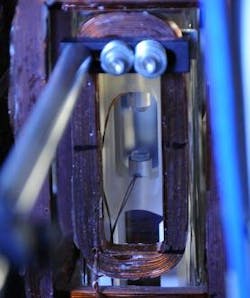JILA demonstrates new type of 'superradiant' laser
Boulder, CO--Physicists at JILA have created an optically pumped "superradiant" deep-red-emitting laser that takes the concept of a directional antenna and applies it to the quantum regime.1 The resulting optical output has a wavelength stability 100 to 1000 times better than that of the best conventional visible lasers—useful for communications, navigation, atomic clocks, and space-based gravitational-wave detectors. JILA is a joint institute of the National Institute of Standards and Technology (NIST) and the University of Colorado Boulder.
In the superradiant regime, the bare atomic linewidth of the gain material is much less than the cavity linewidth. The JILA laser contains about a million rubidium atomic dipoles; during operation, the laser cavity contains only 0.2 photons on average, which isolates the collective atomic dipole from the environment (including cavity-mirror vibrations). As a result, the linewidth of the new laser is more than 10,000 times less than that for the quantum limit of a conventional laser in which the cavity linewidth is much less than the bare atomic linewidth.
The 0.2 photons in the cavity at a time are just enough to maintain an oscillating electric field to sustain the dipoles’ synchronized behavior; nearly all photons escape before they have a chance to become scrambled by the cavity mirrors and disrupt the synchronized atoms, thus averting the very effect that causes laser frequency to wobble in a conventional laser.
While the rubidium atoms ordinarily would emit just one photon per second, their correlated action boosts that rate 10,000-fold, making the light superradiant, according to JILA/NIST physicist James Thompson. This "stimulated emission" meets the definition of a laser (Light Amplification by the Stimulated Emission of Radiation).
Despite its dimness (a million times dimmer than a laser pointer), the light from the superradiant laser can be locked to a normal laser's output, transferring its stability to the other laser. The bright laser, potentially 100 to 1000 times more stable than today's best super-stabilized lasers, could then be used in the most advanced atomic clocks.
REFERENCE:
1. J. G. Bohnet et al., Nature 484, p. 78, April 5, 2012.

John Wallace | Senior Technical Editor (1998-2022)
John Wallace was with Laser Focus World for nearly 25 years, retiring in late June 2022. He obtained a bachelor's degree in mechanical engineering and physics at Rutgers University and a master's in optical engineering at the University of Rochester. Before becoming an editor, John worked as an engineer at RCA, Exxon, Eastman Kodak, and GCA Corporation.
